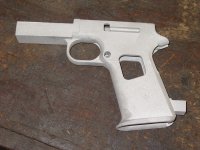RE: The Hound:
I do know what I want: I want a high-quality, all stainless frame, with checkering (front and back strap), a custom trigger job, narrow front sight post with preferably a brass or gold dot--but fiber optic or lamps would do, adjustable rear sights (or simply high quality rear but adjustable are preferable), G-10 grips (not black) VZ, and porting.
I plan on customizing a CZ75 stainless via the CZ Custom Shop. I agree it'd be a good way to go. I know you say I don't need porting. I also don't "need" another handgun, really. I just want a precision handgun that's better than my full custom Springfield XD V-10, but has many of the same features. I've fired CZ75's a fair amount. I know they don't recoil much... I just want them to recoil as little as possible. I also will probably get two barrels, if I internally port a CZ75, like my XD V-10. I have a threaded barrel for my XD, that if I don't want porting (let's say for a new shooter), I can throw it into my gun.
But, a 1911, I'll admit, appeals to me, too. I apologize if I seem scattered. I have more ideas than dollars. The reason I am asking about T.O. 1911's is just because it has some of the features I'd want. Pretty much nobody has a gun sub-$2,000 that fulfills my desires, so building a gun up makes a lot of sense to me. I'll go back to the barrel bushing comp again, because a 1911 with a bushing compensator would save me the expense of having two barrel sets AND Magnaporting.
I think that a full-custom CZ75 might present the best value to me over a 1911, but I may want a 1911 someday anyway, which is why I am asking questions and trying to learn more about the type. I really appreciate your and other people's feedback.
I've thought about the G34 route before, especially a full-custom Lone Wolf build, because it is super easy to do porting and non-porting, but the whole reason I want a new gun is because I want a "better" gun than my custom XD. A Glock/Lonewolf is just not much of a step up from my XD, and having fired Venom1956's CZ75 a lot, I know I shoot a CZ better than my XD, even a stock one.
I like 1911's but pretty much the only 1911's that I've fired that have impressed me were a 9mm Springfield Range Officer, a DW Pointman 9, and a DW Valor.
Do I make more or less sense than I did before? I'm guessing less...



